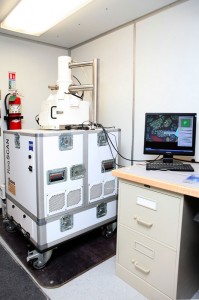Portable rock analyzer delivers success in Wolfcamp Shale
By Katie Mazerov, contributing editor
A new high-resolution, real-time system for analyzing wellsite mineralogy has been used successfully in field tests in the lucrative Wolfcamp Shale formation in the Permian Basin of West Texas and New Mexico.
The oil and gas play, sometimes referred as the Wolfberry Trend, lies beneath the Spraberry formation and has a mineral composition and lithology similar to the Eagle Ford play. The play, with depths ranging from 5,000 ft to 15,000 ft and a complex carbonate/mudstone lithology as thick as 2,500 ft, is believed to have gross oil reserves of 2.1 bbls oil equivalent.

RoqSCAN, the portable rock properties analyzer, is a collaborative effort of Fugro Robertson and Carl Zeiss, the world’s first manufacturer of portable scanning electronic microscope solutions. Results of the 10-week field test, conducted for Denver-based Forest Oil on a vertical pilot well and a long, horizontal pair, were announced at the SPE Annual Technical Conference and Exhibition in Denver 31 October to 2 November.
More than 600 rock samples were collected, analyzed and interpreted by the RoqSCAN system. The test was designed to prepare samples in the field in less than 18 minutes; continuously generate quantitative mineralogical data; minimize machine downtime; test engineer/support response times and test environmental limitations such as temperature and humidity. RoqSCAN analyzes wellbore cuttings and core samples and generates data in the form of a downhole log within one hour of receiving the cuttings.
Game-changing technology
The technology is being viewed as a game-changer in wellbore analysis in terms of the amount, type, speed and quality of rock properties data collected over traditional core sampling and cuttings analysis. Traditional methods can be costly, often result in rig downtime, test only a portion of the well or reservoir section and typically have a lag time between data retrieval and analysis, according to Fugro Robertson.
“The extensive field test has demonstrated that our RoqSCAN system has delivered value to our client on site,” said Dr Guy Oliver, president of Fugro Robertson. “The value is derived from highly quantitative rock properties data, generated at the wellsite and being made immediately available to the operator for assistance in key decision-making, or simply not having to wait two months for the samples to be analyzed in a laboratory.” Fugro Robertson was the first company to use cuttings data to assist with horizontal well steering in the early 1990s.
In drilling the horizontal well, RoqSCAN generated mineralogical data up to 30 minutes faster than the measurement while drilling (MWD) tool used over the same interval, Dr Oliver noted.
Additionally, the company’s RoqFRAC curve analysis, which assists operators in interpreting the data, generated information on the brittleness versus ductility of the well, allowing the operator to assess the frac-ability over the entire length of the lateral target interval, Dr Oliver said. Forest Oil will use the data to determine tactical positioning of the hydraulic fracturing stages.
Proximate to the resource-rich Eagle Ford, Granite Wash and Bone Spring formations, the Wolfcamp play is attracting operators that have ongoing operations in those regions as well as the Permian Basin. Forest Oil is currently engaged in a $50 million capital program in the play.
RoqSCAN is a trademarked term of Fugro Robertson.




